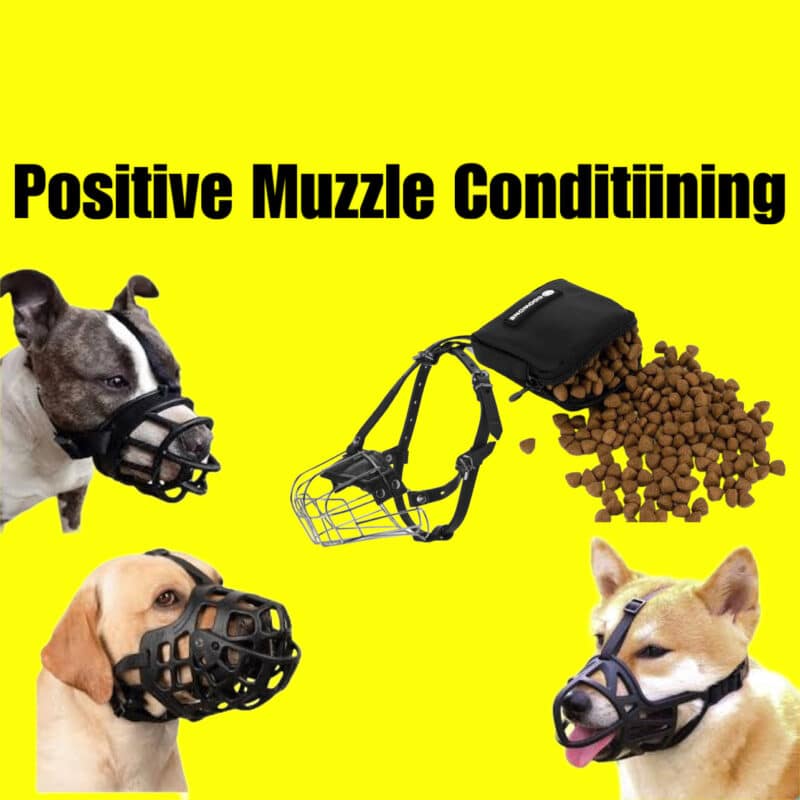Advanced Pet Care, Dog Training and Behavior, Pet Safety, Training Techniques, Uncategorized
The Comprehensive Guide to Positive Muzzle Training for Dogs: Step-by-Step, Science-Backed Methods for Safe and Effective Training
Posted on by Dog Behaviorist
Positively Conditioning Your Dog to a Basket Muzzle: A Comprehensive, Evidence-Based Guide
By Will Bangura, M.S., CDBC, CBCC-KA, CPDT-KA, FFCP, (Dog Behaviorist), Certified Dog Behavior Consultant.Introduction
Conditioning your dog to wear a muzzle can be an invaluable training tool for various behavioral or safety reasons. Whether you’re dealing with reactive behavior, medical issues that warrant precaution, or are preparing your pet for a stress-free visit to the vet, a muzzle can be a useful and humane management tool when used correctly. This comprehensive guide aims to provide detailed, step-by-step instructions on positively conditioning your dog to a basket muzzle using a blend of expert knowledge and proven science-based techniques. In doing so, we’ll employ strategies of positive reinforcement and counterconditioning, two powerful tools in canine behavioral modification (McGreevy et al., 2008).Why Choose a Basket Muzzle?
Basket muzzles offer a spacious design that allows dogs to pant, drink water, and receive treats, making them ideal for longer periods of wear and more comfortable for the dog. Additionally, their rigid structure offers a higher level of safety by preventing biting (Overall, 2013).Preparing for Muzzle Training
Before starting the conditioning process, it’s crucial to have:- A well-fitted basket muzzle that allows the dog to pant and drink water.
- High-value treats or a dog-safe spreadable substance, like peanut butter, to entice your dog to interact with the muzzle.
- A comfortable, distraction-free environment for training.
Week 1-2: Initial Positive Conditioning
Strategy 1: Making the Muzzle a Food Bowl
- Wrap the Muzzle: Begin by wrapping the outer surface of the basket muzzle with plastic wrap. This will create a non-porous surface to place food.
- Place Food: Add a portion of your dog’s meal or high-value treats inside the muzzle.
- Encourage Interaction: Place the muzzle, food side up, in front of your dog and encourage them to eat from it.
- Verbal Cue: Each time your dog puts its snout in the muzzle to eat, say the cue word, “Muzzle,” to build a positive association.
- Consistency: Repeat this process daily for two weeks. The dog should not wear the muzzle or have the straps buckled during this phase.
Strategy 2: Peanut Butter Approach
- Prepare the Muzzle: Use clear packing tape to cover the inside of the basket muzzle.
- Smear Peanut Butter: Apply a layer of dog-safe peanut butter on the tape.
- Verbal Cue and Interaction: Just as in Strategy 1, say “Muzzle” as your dog places its snout in the muzzle to lick the peanut butter.
- Daily Routine: This too should be a daily exercise for the first two weeks, without buckling the muzzle on your dog.
Week 3-4: Buckle, Feed, and Unbuckle
After spending two weeks creating a positive association with the muzzle, it’s time to advance to the next stage: getting your dog comfortable with having the muzzle buckled.Step-by-Step Guide
- Buckle Preparation: Have the muzzle and high-value treats within easy reach.
- Verbal Cue: As your dog places its snout into the muzzle, say “Muzzle” to reinforce the positive association.
- Buckle the Muzzle: Gently buckle the straps behind your dog’s head. Do this quickly but without making abrupt movements that could startle your dog.
- Immediate Reward: As soon as the muzzle is buckled, feed your dog multiple high-value treats through the spaces in the basket muzzle. This reinforces that buckling leads to treats (Lindsay, 2001).
- Unbuckle: After feeding the treats, immediately unbuckle the muzzle.
- Duration: Start with very short periods, such as 5-10 seconds, and gradually increase the time the muzzle stays buckled over the course of two weeks.
- Frequency: Repeat this exercise several times a day, aiming for short but frequent training sessions to keep your dog engaged and prevent fatigue.
- Troubleshooting: If your dog shows signs of stress, such as pawing at the muzzle or trying to remove it, you may need to revert to the initial conditioning steps or shorten the duration it’s buckled.
Note on Consistency
Consistency in training is key, so make sure to practice these steps daily for about two weeks. The goal is to build up to a point where your dog comfortably allows you to buckle and unbuckle the muzzle without any sign of stress or resistance (Overall, 2013).Week 5: Introduction to Movement
Now that your dog is comfortable with having the muzzle buckled, it’s time to introduce movement to help them acclimate to walking while wearing it.Steps for Successful Introduction to Movement
- Prepare for a Walk: With the muzzle and treats prepared, put on your dog’s leash.
- Buckle and Reward: Buckle the muzzle and offer treats through the basket, just as you’ve practiced.
- Start Walking: Begin walking at a slow pace within a controlled environment.
- Verbal Reinforcement: Use encouraging words like “Good” or “Nice” to motivate your dog as you walk.
- Duration: Start with short walks, approximately 1-2 minutes, and slowly extend the time as your dog gets more comfortable.
- Observe: Watch for any signs of distress or attempts to remove the muzzle. If this happens, shorten the walking time and consider additional counterconditioning.
- Reward and Unbuckle: Once the walk is complete, offer more treats before unbuckling the muzzle.
Troubleshooting Common Issues
Even with meticulous training, you might face some hurdles. Knowing how to navigate them can make the difference between successful muzzle conditioning and potential setbacks.Pawing at the Muzzle
If your dog starts pawing at the muzzle, it may indicate discomfort or anxiety.- Solution: Revert to shorter periods of muzzle-wearing and reintroduce treats or food more frequently to rebuild positive associations (Lindsay, 2001).
Resistance to Buckling
If your dog becomes resistant to having the muzzle buckled, it could be a sign of negative associations forming.- Solution: Consider going back to the basics of initial positive conditioning, utilizing higher-value treats or activities your dog loves (Overall, 2013).
Advanced Training Techniques
After your dog has grown comfortable with wearing the muzzle during walks, you might want to introduce additional complexities like longer durations or varying environments.- Incremental Increase in Duration: Gradually extend the amount of time your dog wears the muzzle, making sure to keep the experience positive by rewarding with treats (Hiby et al., 2004).
- Different Environments: Start incorporating the muzzle in various settings—indoors, outdoors, around other animals—to generalize the positive association.
- Vet and Groomer Visits: Prepare your dog for vet visits by mimicking conditions they would experience there, like handling paws or ears while they wear the muzzle (McGreevy et al., 2008).
Summary
Successfully muzzle training your dog is a multi-week endeavor that demands patience, consistency, and an understanding of positive reinforcement and counterconditioning techniques. With a science-backed approach, you can make a muzzle a positive and accepted part of your dog’s life, enabling safer interactions and potentially even enriching their world.References
Lindsay, S. R. (2001). Handbook of Applied Dog Behavior and Training, Vol. 1: Adaptation and Learning. Iowa State University Press. Overall, K. L. (2013). Manual of Clinical Behavioral Medicine for Dogs and Cats. Elsevier Health Sciences. Hiby, E. F., Rooney, N. J., & Bradshaw, J. W. (2004). Dog training methods: their use, effectiveness and interaction with behaviour and welfare. Animal Welfare, 13(1), 63-69. McGreevy, P., Wilson, B., Starling, M. J., & Serpell, J. A. (2008). Behavioral Risks in Male Dogs with Minimal Lifetime Exposure to Gonadal Hormones May Complicate Population-Control Benefits of Desexing. PLOS ONE, 3(5), e5248
Facebook
Twitter
LinkedIn

